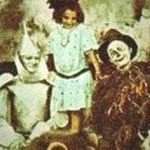 Movies and TV
Movies and TV  Movies and TV
Movies and TV  History
History 10 Things You Didn’t Know About the American National Anthem
 Technology
Technology Top 10 Everyday Tech Buzzwords That Hide a Darker Past
 Humans
Humans 10 Everyday Human Behaviors That Are Actually Survival Instincts
 Animals
Animals 10 Animals That Humiliated and Harmed Historical Leaders
 History
History 10 Most Influential Protests in Modern History
 Creepy
Creepy 10 More Representations of Death from Myth, Legend, and Folktale
 Technology
Technology 10 Scientific Breakthroughs of 2025 That’ll Change Everything
 Our World
Our World 10 Ways Icelandic Culture Makes Other Countries Look Boring
 Misconceptions
Misconceptions 10 Common Misconceptions About the Victorian Era
 Movies and TV
Movies and TV The 10 Coolest Stars to Set Sail on The Love Boat
 History
History 10 Things You Didn’t Know About the American National Anthem
 Technology
Technology Top 10 Everyday Tech Buzzwords That Hide a Darker Past
Who's Behind Listverse?

Jamie Frater
Head Editor
Jamie founded Listverse due to an insatiable desire to share fascinating, obscure, and bizarre facts. He has been a guest speaker on numerous national radio and television stations and is a five time published author.
More About Us Humans
Humans 10 Everyday Human Behaviors That Are Actually Survival Instincts
 Animals
Animals 10 Animals That Humiliated and Harmed Historical Leaders
 History
History 10 Most Influential Protests in Modern History
 Creepy
Creepy 10 More Representations of Death from Myth, Legend, and Folktale
 Technology
Technology 10 Scientific Breakthroughs of 2025 That’ll Change Everything
 Our World
Our World 10 Ways Icelandic Culture Makes Other Countries Look Boring
 Misconceptions
Misconceptions 10 Common Misconceptions About the Victorian Era
10 Brilliant Italian Giallo Films
Giallo is the Italian mystery/horror genre that was most prominent from 1970 to 1975. It takes its name from the term for the mystery novels being published in Italy around the same time. These novels had yellow covers (Giallo is Italian for “Yellow.”) The films eventually gained a reputation for gratuitous violence and sexuality and their murder scenes served as a big influence on the American Slasher film. The genre has its greats, as well as its fair share of duds. Here are 10 Gialli that are worth your time. WARNING: some of the clips below contain violence, sex, and gore.
This is where the genre really started. Bava adapted the Italian Giallo mystery novels into this story of an American tourist in Italy who witnesses a murder and takes it upon herself to investigate. This set the standard for the Giallo set up, and though it’s not very gory, it’s an entertaining film and a good introduction to the genre. If you enjoy this one, then you should take a look at the next step Bava took toward defining the giallo with “Blood and Black Lace.” Unfortunately the clip above doesn’t have subtitles, but the DVD copy does.
Lamberto is Mario’s son and though his efforts often fall flat, this is an enjoyable giallo about a composer working on a film score whose housemates are murdered. He’s nowhere near as good as his dad, but Lamberto’s first giallo stands above many of the genre’s other entries by bringing energy to the giallo, even after its prime.
The mystery here is intricate and set up very well. It involves a diamond thief and features beautiful women and an active camera. This is the best of Ercoli’s three Gialli, though this film’s companion piece, “Death Walks at Midnight” is good as well. Check this one out for a giallo that is indulgent in both story, setting, and characterization.
Full title: “Your Vice Is a Locked Room and Only I Have the Key”. Part ghost story, part infidelity drama, and part appropriation of Poe’s “The Black Cat”, this Giallo is on the bizarre side of things and goes to great lengths to manipulate the giallo set up, while giving the viewer everything they expect from it. That is: Nudity, violence, and a great mystery (not to mention a very strange opening scene set at a party). Also, there are some elements at play here that seem awfully similar to a few events in “The Shining.” Namely, an alcoholic writer and a strange repetitive message on his typewriter.
Drugs show up as major players from time to time in gialli. Though better known for “Zombi 2,” Lucio Fulci is responsible for one of the more interesting giallo drug commentaries. Though a bit ridiculous at times, this film is a compelling mystery about a woman who dreams of murdering her neighbor. The neighbor shows up dead and in a way very similar to her dreams. The film features some wacky stances on drugs, but one can’t help but be creeped out by the eerie atmosphere provided by Fulci’s style and a certain two witnesses to the film’s major murder.
A great place to begin exploring the genre’s commentary on sexuality, this film feature a killer who paralyzes his victims before killing them. The plot involves some unique trickery to fool the viewer. Also, this film gets away from the standard “innocent bystander witnesses crime and investigates” routine seen in many gialli by focusing mostly on a detective who isn’t so sure about his career.
Fulci is one of the greats, and he warrants another spot on the list with this film. He resets the giallo away from it’s usual urban locale by placing this film in rural Sicily. The film deals heavily with issues of morality and religion, and does so better than most of the many other gialli that take on the task. With the help of a few very memorable scenes (specifically a graveyard beating and a mountainside showdown), this one really stands out amongst its contemporaries.
Considered by some to be the greatest giallo, Argento, a pioneer of the genre, brings the formula close to perfection here. The film is in a way a reworking of Michelangelo Antonioni’s 1966 film “Blow Up” (it even features the same lead actor) and was intended as Argento’s final giallo before he focused on supernatural thrillers like the film he is most famous for, “Suspiria.” It’s the giallo in possibly it’s most focused and thoughtful state, but it can be a bit difficult for those not acquainted with Argento or the genre, and it may be a good idea to start with this list’s number one film instead. If you enjoy “Deep Red,” Argento’s return to the genre after his run with supernatural thrillers, “Tenebre,” is a well executed and thoughtful commentary on the genre that both embraces and judges its standards.
1971 was a good year for the giallo, and the genre’s originator couldn’t help but take the opportunity to shake it up in the midst of its success. Also known as “Twitch of the Death Nerve,” “Bay of Blood” employs another common theme in gialli: Greed. As many parties fight for an inheritance, someone starts killing. With this set up, Mario Bava creates the slasher film formula and creates some death scenes that would show up nearly unchanged in the “Friday the 13th” films a decade later. A great first giallo for cross-over fans of the American slasher film.
Although “The Girl Who Knew Too Much” and “Blood and Black Lace” were the first real gialli, “The Bird with the Crystal Plumage” was the first film to combine the former’s plot and the latter’s gore and sexuality together in one package. A gripping film by any standard, Argento’s first film is a textbook definition of the genre, and it will capture any viewer. This one is definitely recommended as a first, as well for repeated viewing. Gialli rarely come together with this kind of balance, and it is the purity and ease of this film that the genre’s major players would chase for the next five years. Beautiful visuals and a number of great twists make this one a must see. It’s also the first in Argento’s so-called “Animal Trilogy,” followed by “The Cat O’Nine Tails” and “Four Flies on Grey Velvet,” which are both great as well.








